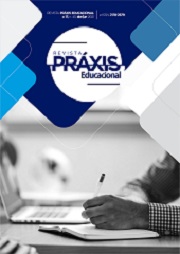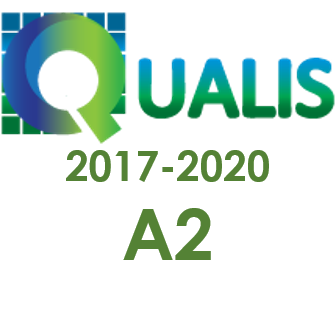Mecánica de juego en narrativa para apoyar a estudiantes con dislexia: percepciones de alumnos y profesores
DOI:
https://doi.org/10.22481/praxisedu.v17i45.8345Palabras clave:
Narrativa gamificada, Mecánicas de juego, Estudiantes con dislexiaResumen
Este artículo presenta el proceso de desarrollo y prueba de un prototipo de narrativa gamificada que tiene como objetivo apoyar el aprendizaje de la lectura de estudiantes con dislexia. La motivación, el compromiso y el aprendizaje fueron los dominios medidos desde las perspectivas de los participantes recogidas a través de escalas y entrevistas abiertas. Los datos de la entrevista fueron grabados en audio después de la prueba del recurso y, posteriormente, transcritos y analizados mediante la técnica de análisis de contenido. En cuanto a las escalas, estas se aplicaron después de la prueba. Son presentados el proceso de diseño, destacando el marco, y los principios y estrategias del juego utilizados. Los principales resultados muestran indicadores de la contribución de los elementos del juego aplicados al recurso para los dominios evaluados.
Descargas
Métricas
Citas
ALVES, F. Gamification: como criar experiências de aprendizagem engajadoras. São Paulo: DVS Editora, 2014.
BARDIN, L. Análise de conteúdo. 4ª. ed. Lisboa: Edições 70, 2009.
CARROL, M. P. Shoot For The Moon! The Mentors and the Middle Schoolers Explore the Intersection of Design Thinking and STEM. In: Journal of Pre-College Engineering Education Research, v. 4, n. 1, 2014. Disponível em: https://docs.lib.purdue.edu/cgi/viewcontent.cgi?article=1072&context=jpeer. Acesso em 20 abr. 2019.
CARVALHAIS, L. Construção de Instrumentos de Avaliação da Dislexia. 375 f. Tese (Doutorado em Psicologia da Educação) – Departamento de Ciência da Educação, Universidade de Aveiro, Aveiro, 2010.
COUTINHO, C. Metodologia de investigação em ciências sociais e humanas: teoria e prática. 2. ed. Coimbra: Edições Almedina, 2016.
DETERDING, S.; DIXON, D.; KHALED, R.; NACKE, L. From game design elements to gamefulness: Defining gamification. In: MINDTREK 2011, 11., 2011, Tampere. Anais […]. Tampere: DBLP 2011. p. 9-15. Disponível em: https://dblp.org/db/conf/mindtrek/mindtrek2011. Acesso em 20 de abr. de 2019.
DIANA, J.; GOLFETTO, I.; BALDESSAR, M.; SPANHOL, F. Gamification e teoria do flow. In: FADEL, M.; ULBRIGHT, R.; BATISTA, R.; VANZIN, T. (eds.). Gamificação na Educação. São Paulo: Pimenta Cultural, 2014.
FRANCESCHINI, S.; GORI, S.; RUFFINO, M.; VIOLA, S.; MOLTENI, M.; FACOETTI, A. Action Video Games Make Dyslexic Children Read Better. In: Current Biology, n. 23, v.6, p. 462–466. Doi:10.1016/j.cub.2013.01.044. Acesso em 13 de abr. 2019.
GAGGI, O.; GALIAZZO, G.; PALAZZI, C.; FACOETTI, A.; FRANCESCHINI, S. A Serious Game for Predicting the Risk of Developmental Dyslexia in Pre-Readers Children. In: Anais […] (ICCCN), 2012. https//:doi:10.1109/icccn.2012.6289249. Acesso em 30 de mar. 2018.
GOOCH, D., VASALOU, A., BENTON, L., KHALED, R. Using Gamification to Motivate Students with Dyslexia, 2016. Disponível em: https://www.researchgate.net/publication/291116195_Using_Gamification_to_Motivate_Students_with_Dyslexia. Acesso em: 17 mar. 2017.
KAPP, K.; BLAIR, L.; MESCH, R. The gamification of learning and instruction: game-based methods and strategies for training and education. São Francisco: Wiley & sons, 2014.
KAPP, K. The Gamification of Learning and Instruction Field book: into Practice. São Francisco: John Wiley & Sons, 2013.
Kronk, H. Dyslexia dragon develops a gamified platform to help learners read and spell. Elearning Inside. 2018. Disponível em: https://news.elearninginside.com/dyslexia-dragondevelops-gamified-platform-help-learners-read-spell/. Acesso em 14 de ag. 2019.
LI, W.; GROSSMAN, T.; FITZMAURICE, G. Gamicad Tutorial system for first time AutoCAD users. In: Anais do UIST’12, Massachusetts: Cambridge, 2012. Disponível em: https://www.researchgate.net/publication/262333846_GamiCAD_A_gamified_tutorial_system_for_first_time_AutoCAD_users/link/57. Acesso em 20 de abr. 2019.
MARQUES, D. A. O Jogo no Desenvolvimento da Criança Disléxica. Dissertação de Mestrado em Ciências da Educação na Especialização em Educação Especial: Domínio Cognitivo e Motor. Escola Superior de Educação João de Deus, Lisboa, 2014.
MUNTEAN, C. Raising engagement in e-learning through gamification. In: Anais […], Bucharest, 2011, p. 323-329. Disponível em: https://www.academia.edu/36387149/Raising_engagement_in_e_learning_through_gamification. Acesso em 14 de mai. 2018.
RELLO, L.; BALLESTEROS, M.; ALI, A.; SERRA, M.; SÁNCHEZ, D.; BIGHAM, J. Dytective: Diagnosing Risk of Dyslexia with a Game, 2016. https://doi: 10.1145/1235. Acesso em 20 de abr. 2019.
RELLO, L., BAYARRI, C.; GORRIZ, A. What is Wrong with this Word? Dyseggxia: A Game for Children with Dyslexia Categories and Subject Descriptors. In Anais […].,6–7. Disponível em:
http://www.luzrello.com/Piruletras_(Dyseggxia)_files/assets2012dyseggxia.pdf. Acesso em: 6 jun. 2018.
ROMINUS, M.; EKLUND, K.; PESU, L.; LYYTINEN, H. (Supporting struggling readers with digital game-based learning. In: Education Tech Research Dev, 67, 639–663, 2019. https://doi.org/10.1007/s11423-019-09658-3. Acesso em 12 de nov. 2019.
SAILER, J.; HENSE, H.; MANDL, H.; KLEVERS, M. Psychological Perspectives on Motivation through Gamification. In: Interaction Design and Architecture(s) Journal, n. 19, p. 28-37, 2013. Disponível em: https://core.ac.uk/download/pdf/26951671.pdf. Acesso em 13 de dez. 2020.
SAPUTRA, M. LexiPal: Design, Implementation and Evaluation of Gamification on Learning Application for Dyslexia. In: International Journal of Computer Applications, n. 131, v. 7, p. 0975-8887, 2015. Doi: https:// 10.5120/ijca2015907416. Acesso em 13 de dez. 2020.
SCHEER, A.; NOWESKI, C.; MEINEL, C. Transforming Constructivist Learning into Acion: Design Thinking in Education. In: Design and Technology Education: An International Journal, n. 17, v. 3, p. 8-12, 2012. Disponível em: https://files.eric.ed.gov/fulltext/EJ996067.pdf. Acesso em: 6 jun. 2018.
SCHIMITZ, B., KLEMKE, R., SPECHT, M. Effects of mobile gamifying patterns on learning outcomes: A literature review. In: Int. J. Technology Enhanced Learning, n. 4, v. 5/6, p. 345-358, 2012. Doi: https:// 10.1504/IJTEL.2012.051817. Acesso em 6 jun. 2018.
SIMÕES, J., REDONDO, R., VILAS, A. Using Flow as a Measurement of Students engagement in a Gamified Social Learning Environment. In: Anais do ICERI 2015, Sevilha, 2015., p. 0291-0301. Disponível em: https://library.iated.org/view/SIMOES2015USI. Acesso em 6 de jun. 2018.
WERBACH, K.; HUNTER, D. For the win: how game thinking can revolutionize your business. Filadélfia: Wharton Digital Press, 2012.
MARQUES, D. A. O Jogo no Desenvolvimento da Criança Disléxica. Dissertação de Mestrado em Ciências da Educação na Especialização em Educação Especial: Domínio Cognitivo e Motor. Escola Superior de Educação João de Deus, Lisboa, 2014.
MUNTEAN, C. Raising engagement in e-learning through gamification. In: Anais […], Bucharest, 2011, p. 323-329. Disponível em: https://www.academia.edu/36387149/Raising_engagement_in_e_learning_through_gamification. Acesso em 14 de mai. 2018.
RELLO, L.; BALLESTEROS, M.; ALI, A.; SERRA, M.; SÁNCHEZ, D.; BIGHAM, J. Dytective: Diagnosing Risk of Dyslexia with a Game, 2016. https://doi: 10.1145/1235. Acesso em 20 de abr. 2019.
RELLO, L., BAYARRI, C.; GORRIZ, A. What is Wrong with this Word? Dyseggxia: A Game for Children with Dyslexia Categories and Subject Descriptors. In Anais […].,6–7. Disponível em:
http://www.luzrello.com/Piruletras_(Dyseggxia)_files/assets2012dyseggxia.pdf. Acesso em: 6 jun. 2018.
ROMINUS, M.; EKLUND, K.; PESU, L.; LYYTINEN, H. (Supporting struggling readers with digital game-based learning. In: Education Tech Research Dev, 67, 639–663, 2019. https://doi.org/10.1007/s11423-019-09658-3. Acesso em 12 de nov. 2019.
SAILER, J.; HENSE, H.; MANDL, H.; KLEVERS, M. Psychological Perspectives on Motivation through Gamification. In: Interaction Design and Architecture(s) Journal, n. 19, p. 28-37, 2013. Disponível em: https://core.ac.uk/download/pdf/26951671.pdf. Acesso em 13 de dez. 2020.
SAPUTRA, M. LexiPal: Design, Implementation and Evaluation of Gamification on Learning Application for Dyslexia. In: International Journal of Computer Applications, n. 131, v. 7, p. 0975-8887, 2015. Doi: https:// 10.5120/ijca2015907416. Acesso em 13 de dez. 2020.
SCHEER, A.; NOWESKI, C.; MEINEL, C. Transforming Constructivist Learning into Acion: Design Thinking in Education. In: Design and Technology Education: An International Journal, n. 17, v. 3, p. 8-12, 2012. Disponível em: https://files.eric.ed.gov/fulltext/EJ996067.pdf. Acesso em: 6 jun. 2018.
SCHIMITZ, B., KLEMKE, R., SPECHT, M. Effects of mobile gamifying patterns on learning outcomes: A literature review. In: Int. J. Technology Enhanced Learning, n. 4, v. 5/6, p. 345-358, 2012. Doi: https:// 10.1504/IJTEL.2012.051817. Acesso em 6 jun. 2018.
SIMÕES, J., REDONDO, R., VILAS, A. Using Flow as a Measurement of Students engagement in a Gamified Social Learning Environment. In: Anais do ICERI 2015, Sevilha, 2015., p. 0291-0301. Disponível em: https://library.iated.org/view/SIMOES2015USI. Acesso em 6 de jun. 2018.
WERBACH, K.; HUNTER, D. For the win: how game thinking can revolutionize your business. Filadélfia: Wharton Digital Press, 2012.
Descargas
Publicado
Cómo citar
Número
Sección
Licencia

Esta obra está bajo una licencia internacional Creative Commons Atribución-CompartirIgual 4.0.
Usted es libre de:
Compartir — copiar y redistribuir el material en cualquier medio o formato; Adaptar — remezclar, transformar y construir a partir del material para cualquier propósito, incluso comercialmente. Esta licencia es aceptable para Obras Culturales Libres. La licenciante no puede revocar estas libertades en tanto usted siga los términos de la licencia.
Bajo los siguientes términos:
Atribución — Usted debe dar crédito de manera adecuada, brindar un enlace a la licencia, e indicar si se han realizado cambios. Puede hacerlo en cualquier forma razonable, pero no de forma tal que sugiera que usted o su uso tienen el apoyo de la licenciante.
No hay restricciones adicionales — No puede aplicar términos legales ni medidas tecnológicas que restrinjan legalmente a otras a hacer cualquier uso permitido por la licencia.










